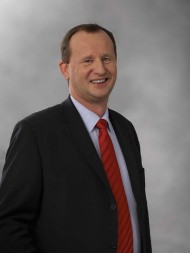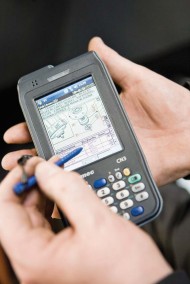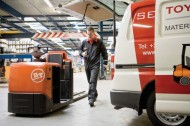 With about 4,500 service engineers and 1,000 sales personnel in the field Toyota Material Handling Europe (TMHE) makes over 15,000 customer contacts every day through its sales and service network. Hans van Leeuwen, TMHE Vice President Sales and Services, explains how this level of customer focus leads to measurable benefits.
With about 4,500 service engineers and 1,000 sales personnel in the field Toyota Material Handling Europe (TMHE) makes over 15,000 customer contacts every day through its sales and service network. Hans van Leeuwen, TMHE Vice President Sales and Services, explains how this level of customer focus leads to measurable benefits.
“There is no doubt that in our type of business we have to develop and manufacture excellent products, but that isn’t enough today. We also have to think and act beyond the hardware, and really understand our customers’ businesses and their daily needs. The fact that we have well over four thousand service engineers on the road reflects this – not, of course, in the context of repairing breakdowns, but in the essential task of preventive maintenance, to ensure trouble-free operations, with maximum truck availability.
We have been analysing the key factors that affect our customers’ businesses for decades, and ultimately the critical issues are performance and cost, together of course with safety and environmental responsibility. By focusing on what customers want to do – which is move goods to their own customers safely and efficiently – we are able to help today’s businesses drive their costs down and their efficiency up.”
You have to understand all costs to effectively drive them down
“Performance is a matter of productivity and reliability, both of which are key values for our products. Understanding cost is a much more complex issue. In order to drive down costs in materials handling operations, one must understand the total life cycle cost related to materials handling equipment, and then identify areas to make cost savings. Our analysis over the past 20 years indicates that for each truck in a given fleet, servicing and fuel on average represent 20% of total lifetime cost. The operator typically accounts for some 70% (unless automation is involved), and operator costs are even higher in multi-shift operations. That means the capital cost for the truck itself is only around 10% or less of the total cost – meaning that cutting overall costs after the sale is the best way to obtain bottom-line benefits.
 “Another way to think about this is to understand that customers want to minimise the cost per load of goods that they move. Of course, productivity is a critical issue, as this will determine the number of trucks required and – more importantly from a cost perspective – the number of drivers they need. This is why we have always emphasised productivity within the design of our trucks. We have also taken the lead in high-density storage and automated solutions. A good example of the former is our BT Radioshuttle aisle-free racking system, while an example of the latter is our automated order picking solution which is delivering major cost reductions and increases in productivity for our customers.
“Another way to think about this is to understand that customers want to minimise the cost per load of goods that they move. Of course, productivity is a critical issue, as this will determine the number of trucks required and – more importantly from a cost perspective – the number of drivers they need. This is why we have always emphasised productivity within the design of our trucks. We have also taken the lead in high-density storage and automated solutions. A good example of the former is our BT Radioshuttle aisle-free racking system, while an example of the latter is our automated order picking solution which is delivering major cost reductions and increases in productivity for our customers.
“Productivity and automation are ways to reduce costs by doing things right, but there are also major cost benefits to be achieved by not doing things wrong. Closer analysis of service cost reveals that for most companies a fair proportion of service and parts cost relates not to maintenance, but to repair – fixing the cost of getting it wrong during truck operation. In fact, repairing damages incurred to trucks during operation typically accounts for around a third of the work our service engineers carry out. This makes avoiding unnecessary damages costs a cornerstone of cost reduction.”
For customers the load is gold
“Further analysis of this ‘cost of getting it wrong’ is extremely revealing. Lift trucks are tough machines, and when a truck gets damaged, something else gets damaged too, and invariably it suffers more than the truck itself. Perhaps the racking, or the building or maybe even the load gets damaged – and that is bad news for our customer, because invariably – for the customer – the load is ‘gold’. Ultimately the load is the reason the truck is there and even the simplest products represent substantial value when stacked on a pallet, usually running into thousands of Euros. In fact our own research is confirmed by the industry experts who estimate that the cost of consequent damage relative to cost of truck damage can be up to 10:1.
“What this means is that there is huge potential waste or damage burdening our customers’ bottom line, and this is another area where we can play a big part in driving down costs. Our Toyota I_Site information system includes detailed reporting on shocks to trucks – helping businesses get to the root cause of damages to trucks, loads and surrounding infrastructure.
With Toyota I_Site our customers are reporting savings of up to 70% in truck damage, with even greater savings in consequential damage to ‘golden’ stock or other equipment.
 “But we have also taken other steps to help take cost out when it comes to load protection. For example, Toyota SAS on our counterbalanced trucks uses intelligent technologies to constantly monitor forklift operations and automatically take corrective action when it senses factors that could lead to truck or load instability. Transitional Lift Control system [TLC] on BT reach trucks mean that loads can be lifted and lowered at full speed without risk of shocks.
“But we have also taken other steps to help take cost out when it comes to load protection. For example, Toyota SAS on our counterbalanced trucks uses intelligent technologies to constantly monitor forklift operations and automatically take corrective action when it senses factors that could lead to truck or load instability. Transitional Lift Control system [TLC] on BT reach trucks mean that loads can be lifted and lowered at full speed without risk of shocks.
Putting it all together
“Another key cost factor is space – typically €3 per pallet position per week, by industry estimates. We understand the significance of this cost area and have developed advanced solutions. BT Radioshuttle helps companies to maximise space utilisation, and even our very narrow aisle (VNA) solutions are advanced, providing up to sixty additional pallet positions per aisle compared to conventional VNA operations. Move to a coldstore environment with space costs increasing by 2.5 times and the savings with TMHE advanced VNA solutions mean that a truck serving five 8m high aisles can realise the value of storage space worth over €60,000 per year.
“But it’s not just at the advanced end of our equipment range that we are able to help drive down cost in customer operations. Take our basic hand pallet truck. It is manufactured in Sweden to the highest standards, and we regularly test our trucks, and those of our competitors, to destruction. As a result we can show that the BT hand truck will typically last five times longer. Yes, there is a small premium to pay in initial purchase cost, but when compared with the cost of five competitor trucks over an equivalent life cycle the cost savings speak for themselves, without even considering the cost of acquisition and disposal – nor the environmental implications.
“In conclusion, TMHE is working closely with customers to help them drive down costs. 15,000 customer contacts every day help us understand today’s customer needs. They have to maximise asset utilisation and consider the use of energy. They need flexibility and reliability. They have to consider future issues in the labour market, which is why we are actively developing automated solutions. They have to focus on cost efficiency and elimination of waste. Our approach to products, service and solutions is designed to give maximum support in all of these goals.”
Toyota Material Handling Europe




Comments are closed.